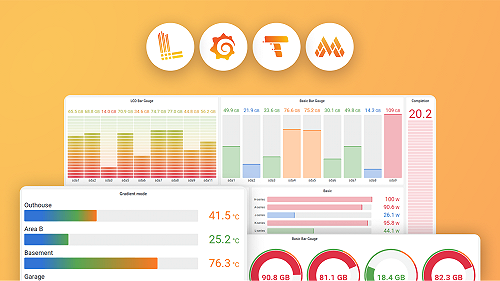Instrument a Go application
If you need process-level telemetry for Go, follow this guide to set up the upstream OpenTelemetry SDK for Go for Application Observability.
Recommended setup for Grafana Cloud
Grafana Labs recommends that you set up OpenTelemetry components, including instrumentation and an OpenTelemetry Collector distribution, using one of the Grafana Cloud setup guides.
These opinionated guides make it easy to get started. They include all the binaries, configuration, and connection parameters you need to set up OpenTelemetry for Grafana Cloud.
Install the SDK
Before you begin, ensure you have a Go 1.22+ development environment and a Go application to instrument.
Run the following command in your project folder:
go get "go.opentelemetry.io/contrib/instrumentation/net/http/otelhttp" \
"go.opentelemetry.io/contrib/instrumentation/runtime" \
"go.opentelemetry.io/otel" \
"go.opentelemetry.io/otel/exporters/otlp/otlpmetric/otlpmetrichttp" \
"go.opentelemetry.io/otel/exporters/otlp/otlptrace" \
"go.opentelemetry.io/otel/exporters/otlp/otlptrace/otlptracehttp" \
"go.opentelemetry.io/otel/sdk" \
"go.opentelemetry.io/otel/sdk/metric"Instrument your application
Create an otel.go file with the following bootstrap code to initialize the SDK and export telemetry:
package main
import (
"context"
"errors"
"go.opentelemetry.io/contrib/instrumentation/runtime"
"go.opentelemetry.io/otel"
"go.opentelemetry.io/otel/exporters/otlp/otlpmetric/otlpmetrichttp"
"go.opentelemetry.io/otel/exporters/otlp/otlptrace"
"go.opentelemetry.io/otel/exporters/otlp/otlptrace/otlptracehttp"
"go.opentelemetry.io/otel/propagation"
"go.opentelemetry.io/otel/sdk/metric"
"go.opentelemetry.io/otel/sdk/trace"
"log"
"time"
)
// setupOTelSDK bootstraps the OpenTelemetry pipeline.
// If it does not return an error, make sure to call shutdown for proper cleanup.
func setupOTelSDK(ctx context.Context) (shutdown func(context.Context) error, err error) {
var shutdownFuncs []func(context.Context) error
// shutdown calls cleanup functions registered via shutdownFuncs.
// The errors from the calls are joined.
// Each registered cleanup will be invoked once.
shutdown = func(ctx context.Context) error {
var err error
for _, fn := range shutdownFuncs {
err = errors.Join(err, fn(ctx))
}
shutdownFuncs = nil
return err
}
// handleErr calls shutdown for cleanup and makes sure that all errors are returned.
handleErr := func(inErr error) {
err = errors.Join(inErr, shutdown(ctx))
}
prop := propagation.NewCompositeTextMapPropagator(
propagation.TraceContext{},
propagation.Baggage{},
)
otel.SetTextMapPropagator(prop)
traceExporter, err := otlptrace.New(ctx, otlptracehttp.NewClient())
if err != nil {
return nil, err
}
tracerProvider := trace.NewTracerProvider(trace.WithBatcher(traceExporter))
if err != nil {
handleErr(err)
return
}
shutdownFuncs = append(shutdownFuncs, tracerProvider.Shutdown)
otel.SetTracerProvider(tracerProvider)
metricExporter, err := otlpmetrichttp.New(ctx)
if err != nil {
return nil, err
}
meterProvider := metric.NewMeterProvider(metric.WithReader(metric.NewPeriodicReader(metricExporter)))
if err != nil {
handleErr(err)
return
}
shutdownFuncs = append(shutdownFuncs, meterProvider.Shutdown)
otel.SetMeterProvider(meterProvider)
err = runtime.Start(runtime.WithMinimumReadMemStatsInterval(time.Second))
if err != nil {
log.Fatal(err)
}
return
}Edit your main.go to set up the SDK and instrument the HTTP server using the go.opentelemetry.io/contrib/instrumentation/net/http/otelhttp library:
package main
import (
"context"
"errors"
"log"
"net"
"net/http"
"os"
"os/signal"
"time"
"go.opentelemetry.io/contrib/instrumentation/net/http/otelhttp"
)
func main() {
if err := run(); err != nil {
log.Fatalln(err)
}
}
func run() (err error) {
// Handle SIGINT (CTRL+C) gracefully.
ctx, stop := signal.NotifyContext(context.Background(), os.Interrupt)
defer stop()
// Set up OpenTelemetry.
otelShutdown, err := setupOTelSDK(ctx)
if err != nil {
return
}
// Handle shutdown properly so nothing leaks.
defer func() {
err = errors.Join(err, otelShutdown(context.Background()))
}()
// Start HTTP server.
srv := &http.Server{
Addr: ":8080",
BaseContext: func(_ net.Listener) context.Context { return ctx },
ReadTimeout: time.Second,
WriteTimeout: 10 * time.Second,
Handler: newHTTPHandler(),
}
srvErr := make(chan error, 1)
go func() {
srvErr <- srv.ListenAndServe()
}()
// Wait for interruption.
select {
case err = <-srvErr:
// Error when starting HTTP server.
return
case <-ctx.Done():
// Wait for first CTRL+C.
// Stop receiving signal notifications as soon as possible.
stop()
}
// When Shutdown is called, ListenAndServe immediately returns ErrServerClosed.
err = srv.Shutdown(context.Background())
return
}
func newHTTPHandler() http.Handler {
mux := http.NewServeMux()
// handleFunc is a replacement for mux.HandleFunc
// which enriches the handler's HTTP instrumentation with the pattern as the http.route.
handleFunc := func(pattern string, handlerFunc func(http.ResponseWriter, *http.Request)) {
// Configure the "http.route" for the HTTP instrumentation.
handler := otelhttp.WithRouteTag(pattern, http.HandlerFunc(handlerFunc))
mux.Handle(pattern, handler)
}
// Register handlers.
handleFunc("/rolldice", rolldice)
// Add HTTP instrumentation for the whole server.
handler := otelhttp.NewHandler(mux, "/")
return handler
}Run your application
Run your application with the following command:
# to use http instead of https
# needed because of https://github.com/open-telemetry/opentelemetry-go/issues/4834
OTEL_EXPORTER_OTLP_INSECURE="true" \
OTEL_RESOURCE_ATTRIBUTES="service.name=<name>,service.namespace=<namespace>,deployment.environment=<environment>" \
OTEL_EXPORTER_OTLP_ENDPOINT=<endpoint> \
go run .Replace variables in <...> with values specific to your application and backend. For more details, see the OpenTelemetry service attributes documentation.
<name>: your service name, for example,shoppingcart<namespace>: a string to group related services, such asecommercefor a team that manages several services<environment>: the deployment environment, for example, theproductiondeployment tier
Some backends, such as Grafana Cloud, also require you to set authentication headers in the OTEL_EXPORTER_OTLP_HEADERS environment variable.
Example application
See the Rolldice service for a complete example setup.
